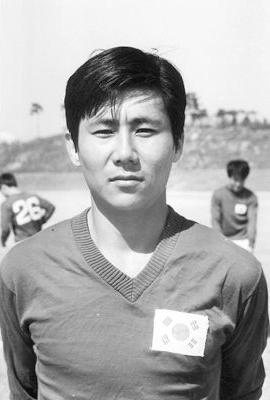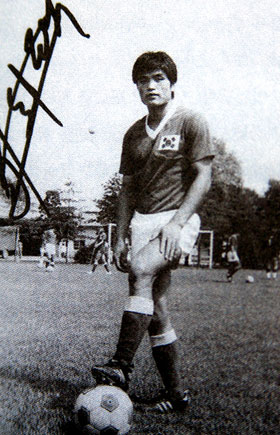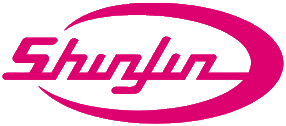| K100 Jeep | |
|---|---|
| Type | 1/4-ton truck |
| Place of origin | South Korea |
| Service history | |
| In service | 1975–unknown |
| Production history | |
| Designer | American Motors Corporation Shinjin Jeep Motor Company |
| Designed | 1974 |
| Manufacturer | Shinjin Jeep Motor Company |
| Produced | 1974–1978 |
The K100 "Jeep" is a 4x4 1/4-ton multi-purpose truck developed by American Motors Corporation and Shinjin Jeep Motor Company (now KG Mobility) for the Republic of Korea Armed Forces in 1974. The K100 joined the armed forces in 1975 and was produced as a gap-filler until the start of mass production of the K111 Jeep in 1978. [1]
In March 1969, Shinjin Motor Company and Kaiser Jeep signed a technical partnership to locally assemble complete knock-down kits for 3,000 Jeep CJ-5s every year. To receive a cash loan from the government, Shinjin Motor claimed the Jeeps would be supplied to the Republic of Korea Reserve Forces; however, the company also had the intention of selling them to the public market. Later, the government was criticized for granting an unfair financial advantage to Shinjin Motor. [2] [3] [4] [5]
On 15 July 1969, Shinjin Motor began constructing a new factory in Busan. In the meantime, 450 CJ-5s were built in the factory located in Bupyeong from November 1969 to March 1970. The completion ceremony for the new factory was held on 15 April 1970. [4] [6]
On 3 April 1970, Shinjin Motor donated three CJ-5s to the Blue House, which were then transferred to the ROK Reserve Forces by President Park Chung Hee on 30 April, making them the first vehicles operated by the military. The Korean National Police also became the operator of CJ-5s on 10 December 1970. [7] [8] [9]
On 29 September 1972, Shinjin Motor announced its plan to create a 50-50 joint venture with the American Motors Corporation, which had acquired Kaiser Jeep in 1970, to increase its capability of manufacturing the vehicles. On 14 July 1973, two companies signed an agreement for the creation of Shinjin Jeep to produce 500 Jeeps every month for both the Korean military and the domestic market. Shinjin Motor had manufactured a total of 3,800 CJ-5s under the previous agreement with Kaiser Jeep. [10] [11]
On 6 April 1974, Shinjin Jeep Motor Company, Ltd. was established. Since then, American Motors has stopped supplying the four-cylinder engine, instead switching to the six-cylinder engine, and has tried to sell the militarized Jeep, which was first revealed on 2 October, to the South Korean military. However, the V6 engine became a burden rather than beneficial for the military as it consumed more fuel, and none of the V4 models experienced underpower problems while operating on hilly terrain during the Korean War. Moreover, local production of parts was not allowed due to the agreement with American Motors, and American Motors had full control over design modifications, including the selection of engine type. [12] [13] [14]
The "militarized" V6 CJ-5 was not truly a militarized vehicle, as it shares many parts with the civilian variant and was disqualified by the Korean military for being substandard after field operations. The biggest problem with the vehicle was its incompatibility with other Jeep-type vehicles operated by the military, which complicates logistics. However, despite the issues, the K100 was put into service in 1975 as the Korean military needed immediate replacements for older Jeep variants. In the same year, the South Korean Ministry of National Defense reported that the military must shift from U.S. aid to self-procurement due to the change in the United States' policy. When President Park received the report, he decided to take advantage of the current situation to pursue the domestic development of such vehicles. [1] [14]
Since then, Shinjin Jeep and Kia Industries have competed to create a new domestic multi-purpose vehicle to replace all compact-sized cars operated by the military. On 25 August 1976, Kia Industries acquired Asia Motors, a dedicated military vehicle repair company, with the long-term goal of delivering military vehicles to the Korean military. Eventually, Asia Motors was selected as the provider in April 1978, and mass production of the K111 began in July. [15] [16] [17] [18]
After losing competition and poor sales in South Korea, American Motors Corporation withdrew and terminated its partnership with Shinjin Motor Company in March 1979. Two companies also had a disagreement regarding the export of Shinjin-made Jeeps because they could disrupt the existing market. [18] [19] [20]
After the end of the partnership, Shinjin Motor began exporting the vehicles as well as changing the V6 gasoline engine, which contributed to the poor sales, to the Isuzu 4BA1 diesel engine without any intervention from American Motors. The company was renamed Geohwa Co., Ltd. on 26 March 1981. [21] [22] [23] [24] [25]

Kim Ho is a South Korean former football player and manager.
Choi Kang-hee is a South Korean football manager and former player; he is the current manager of Chinese Super League club Shandong Taishan.

Kim Jung-nam is a South Korean former football player and manager.

Lee Hoe-taik is a former South Korean football player and manager. He is widely regarded as one of the greatest South Korean forwards of all time. He is also one of four players inducted into the Korean FA Hall of Fame.
The South Korea national under-20 football team represents South Korea in international youth football competitions and also can be managed as under-18 or under-19 team if necessary. South Korean under-20 team won twelve AFC U-20 Asian Cup titles and reached the FIFA U-20 World Cup final once, both are the most successful results among Asian teams.

This article shows unofficial matches of the South Korea national football team. They don't meet the standard of international "A" matches.
The President's Cup National Football Tournament is a football competition, held by Korea Football Association, for South Korean semi-professional and amateur football clubs. This competition was originally one of major club competitions of South Korean football with Korean National Football Championship, but its status was undermined after the professional clubs appeared in South Korea according to the foundation of K League, the South Korean professional league. The tournament is usually held during the early months of the year, typically ending in March.

Shinjin Motors or Sinjin Motors is a defunct South Korean car manufacturer.

Legislative elections were held in South Korea on 27 February 1973 to elect 146 members of the National Assembly. Another 73 members appointed by President Park Chung-hee were indirectly elected by the National Conference for Unification on 7 March 1973.
The Korean National Semi-professional Football Championship was a league cup held by Korean National Semi-Professional Football League. It was the predecessor of the Korea National League Championship.
Sim Myeong-hui is a South Korean former sports shooter. He competed in the trap event at the 1960 Summer Olympics.
Go Se-tae was a South Korean basketball player who competed in the 1956 Summer Olympics. He graduated from Kaesong Songdo Middle School, and went on to attend Korea University. In 1952 he was in military service and played for the Military Manpower Administration basketball team. He later played for the Korea Development Bank team. After his appearance at the Olympics, he became a director of the Korea Basketball Association, and was one of the few directors who did not join the mass resignation after the South Korean team's poor performance at the 1964 Summer Olympics. He died at his home in Hyochang-dong, Yongsan District, Seoul on the morning of 22 April 1986.
Keohwa, Ltd. was a Seoul, South Korea, based assembler of Jeeps under licence, mainly for export markets. Its predecessor was the Jeep assembly joint venture of Shinjin Motors and American Motor Corporation (AMC), established in 1974. It was spun off as an independent company in 1981, after AMC left the venture and retired the permission to use the Jeep trade mark. In 1983, Jeeps from Keohwa started to be named as "Korando" In 1984, Keohwa was acquired by Dong-A Motor, the predecessor of Ssangyong Motor.

Kim Hong-il was a Korean independence activist and a general of the Second Sino-Japanese War and the Korean War, who later became a diplomat and politician in South Korea. Born in North Pyongan, he did his early schooling in China and Korea, and had a brief career as a teacher before his connections with the nascent Korean independence movement led to his imprisonment. He fled into exile in China in 1918, and served in the Kuomintang's National Revolutionary Army from 1926 to 1948, following which he moved to the newly independent South Korea to join the Republic of Korea Army. He commanded South Korea's I Corps during the first year of the Korean War, and was then sent to Taipei as South Korea's ambassador to the Republic of China, which by then had retreated to Taiwan. His assignment there ultimately lasted nine years. He returned to South Korea in 1960 following the April Revolution which ended the rule of Syngman Rhee, and served briefly as Minister of Foreign Affairs under the Park Chung Hee junta. He ran for the National Assembly, first unsuccessfully in 1960 and 1963, and was then elected in 1967 and became a major figure in the opposition New Democratic Party.

Lee Se-yeon is a former South Korean footballer.
Park Kil-chul is a South Korean sailor. He competed in the Finn event at the 1988 Summer Olympics.

This article shows matches of the South Korea national football B team.
The South Korean Footballer of the Year, officially known as Korea Football Association Player of the Year, is an annual award presented to the best South Korean football player in a calendar year by Korea Football Association (KFA).
The KFA Awards is an annual award ceremony hosted by Korea Football Association (KFA).

The K111 "Jeep" is a 4x4 1/4-ton utility truck developed by Asia Motors for the Republic of Korea Armed Forces in 1978. It is commonly known as military Jeep, and its design is based on M606 Jeep. The export name of the vehicle is KM410.
This article needs additional or more specific categories .(May 2024) |